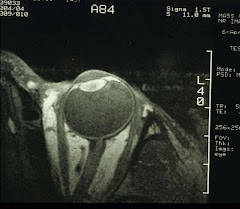The next series (2.X) will discuss various eye diseases associated with aging. And what kind of vision is expected and how to optimize/correct it. More for a comprehensive understanding from a researcher's point of view.
If you look at the tissues in the eye: in some, the cells renew quickly, while in others, the same cells are destined to last a lifetime. It is in the latter group, we have the age-related issue. Now a quick tour of the anatomy of the eye (diagram below courtesy of National Eye Institute, NIH, Bethesda, MD):
 The cornea is bathed in tear fluid in the front and the aqueous humor in the back. Outermost is the epithelium with several layers that regenerate readily. All cells are replaced every 5-7 days. So any injuries to the epithelium is repaired quite nicely. The thickest middle is the stroma composed of collagen fibers that are maintained/repaired by keratocytes. And the innermost is the single-cell-layer endothelium whose cells do not divide if at all. With aging, the endothelium will lose cells. The endothelium can be regarded as a water pump which helps keep the cornea water content constant. The loss of cells by itself is not a major concern; however, additional losses from, e.g., corneal or cataract surgery or mechanical trauma from the IOLs can be a problem. The aging cornea is generally less resistant to infection, probably because of structural changes that have altered its barrier function. The periphery sometimes develop a white ring (known as arcus senilis) that can scatter light and reduce corneal transparency.
The cornea is bathed in tear fluid in the front and the aqueous humor in the back. Outermost is the epithelium with several layers that regenerate readily. All cells are replaced every 5-7 days. So any injuries to the epithelium is repaired quite nicely. The thickest middle is the stroma composed of collagen fibers that are maintained/repaired by keratocytes. And the innermost is the single-cell-layer endothelium whose cells do not divide if at all. With aging, the endothelium will lose cells. The endothelium can be regarded as a water pump which helps keep the cornea water content constant. The loss of cells by itself is not a major concern; however, additional losses from, e.g., corneal or cataract surgery or mechanical trauma from the IOLs can be a problem. The aging cornea is generally less resistant to infection, probably because of structural changes that have altered its barrier function. The periphery sometimes develop a white ring (known as arcus senilis) that can scatter light and reduce corneal transparency.Next is the crystalline lens. It faces the aqueous humor in the front and the vitreous in the back. The adult lens structure, from surface to center is the cortex, adult nucleus, juvenile nucleus, fetal nucleus, and embryonic nucleus. And at the front is the single-cell-layer epithelium. The nucleus of course does not rejuvenate. Most of it is as old as your chronological age. The epithelium does go on producing cortical cell fibers which are layered upon older fibers. And the whole cortex-nucleus complex compacted with time (or you end up with age-related myopia which in fact does not exist). Throughout life, the lens is asked to refract light and itself will have received light-induced damages.
Finally, the retina which, as part of the central nervous system, never regenerates. Any retinal damage is therefore irreversible.
So now we know which tissues may be in trouble once age-related wear-and-tear kicks in and causes damages.











